
95% of researchers rate our articles as excellent or good
Learn more about the work of our research integrity team to safeguard the quality of each article we publish.
Find out more
ORIGINAL RESEARCH article
Front. Earth Sci. , 21 September 2022
Sec. Solid Earth Geophysics
Volume 10 - 2022 | https://doi.org/10.3389/feart.2022.1016924
This article is part of the Research Topic Digital Rock Physics and Machine Learning View all 10 articles
Continental tight oil sandstone reservoirs are developed in the Cretaceous Quentou Formation in the Songliao Basin, China. At present, there is still a lack of research on the reservoir microstructures, reservoir physical properties, and the division scheme of reservoir types in the Quan 3 Member of the Quanzhou Formation. Therefore, in this paper, taking the Quan 3 Member in the Fuxin Uplift Belt of the Songliao Basin as an example, the microscopic pore structure characteristics of tight oil sandstones have been systematically studied, and the classification standard of tight sandstones has been formulated. Furthermore, the sweet spots of the main production layers are predicted. The results show that the I sandstone group in the Quan 3 Member in the study area belongs to shallow water delta facies. Feldspar lithic fine sandstones are developed in the target layer, and calcareous sandstone is locally developed. Moreover, the mian pore types of the target layer include dissolved intergranular and intragranular pores, followed by primary intergranular pores, while micro-fractures are occasionally seen. According to the mercury intrusion test results, the pore-throat structures of the reservoir in the Quan 3 Member are divided into four types: 1) small-pore medium-throat type (point bar and delta distributary channel), 2) small-pore micro-throat type (point bar), 3) small-pore micro-throat type (natural levee), 4) micro-pore micro-throat type (river floodplain and inter-tributary bay). The lower limits of the physical properties of the effective reservoirs in the Quan 3 Member has been determined: the porosity is 10% and the permeability is 0.1 mD. Finally, combined with the study of the mercury intrusion curves, the physical properties and the sedimentary facies, the classification standard of the Quan 3 Member reservoirs was formulated. For the I sandstone group, the sweet spots of the Type I reservoirs are mainly developed in the Fuyu Oilfield in the southeast areas. The sandstones in this area suffered less compaction, and primary and secondary pores suffered from late dissolution are mainly developed.
In recent years, the research focus of clastic oil and gas reservoirs has gradually developed from conventional to unconventional reservoirs such as tight reservoirs, deep reservoirs or volcanic rock reservoirs (Kassem et al., 2021; Lv and Li, 2021; Boutaleb et al., 2022; Cui and Radwan., 2022). The different scales of reservoir heterogeneity, the reasons for the formation of tight oil and gas reservoirs, the origin of various secondary pores, and the division of reservoir types have all become the focus of reservoir geology (Li et al., 2013; Haile et al., 2018; Qiao et al., 2019; Wu et al., 2019; Bello et al., 2021).
Qualitative evaluation has been unable to meet the requirements of fine evaluation of tight reservoir properties. Therefore, the quantitative evaluation of multi-parameter joint characterization has become the mainstream of fine reservoir evaluation (Enayati-Bidgoli and Saemi., 2019; Hijaz et al., 2020; Mirzaei-Paiaman and Ghanbarian., 2021). The previous usually use effective permeability, rock density, effective porosity and permeability of matrix as the core parameters for quantitative evaluation of reservoir properties (Sun et al., 2014; Mahmi et al., 2018; Wu et al., 2020a; Khan et al., 2020; Jabir et al., 2021). In recent years, some new data processing techniques, such as artificial neural network, CT scanning, etc., have also been used to evaluate the oil and gas-bearing properties of tight reservoirs (Li et al., 2005; Liu et al., 2019; Wang et al., 2020).
There are many countries with developed continental sedimentary oil fields. Therefore, oil and gas exploration of fluvial and lacustrine facies sand bodies has received great attention (Yang et al., 2013; Wang et al., 2016; Wu et al., 2020b; Wu et al., 2020c). Fluvial reservoirs are an important type of oil and gas reservoirs in China, accounting for about 38% of the total reserves. The Songliao Basin, located in northeastern China, is a sedimentary basin with the earliest oil discovery in China. At present, the sand bodies of the Quan 3 Member of the Quantou Formation in the Fuxin Uplift, Songliao Basin have complex development characteristics and a low degree of oil and gas exploration. The lack of basic research limits the efficient development of tight sandstone reservoirs in the Quan 3 Member.
On the basis of years of oil and gas exploration achievements in the Fuxin Uplift Belt, this study systematically studies the microscopic pore structure characteristics, reservoir classification standards and sweet spot prediction of the main producing layers of the Quan 3 Member. This study has important theoretical and practical significance for guiding the in-depth oil and gas exploration of the Quan 3 Member of the Fuxin Uplift Belt in the Songliao Basin.
The Fuxin Uplift is located in the central depression in the south of the Songliao Basin in northeastern China (Figure 1A). The area covers the Xinbei, Xinmiao, Xinmin, Xinli, Mutou and Fuyu Oil Fields. The good source-reservoir-caprock combination makes the Fuxin Uplift area have the characteristics of contiguous distribution of reservoirs and good oil-bearing properties. The configuration of oil-generating sags and long-term inherited structural belts has resulted in large-scale accumulation of oil and gas in the Fuxin Uplift area.

FIGURE 1. Location of the study area (Fuxin Uplift) (A) and the comprehensive stratigraphic histogram (B) of this area (From Mei et al., 2020; modified).
The stratigraphic unit division of the Fuxin Uplift belt is shown in Figure 1B. Oil and gas are mainly distributed in the Cretaceous strata. The Cretaceous strata are divided into the Denglouku, Quantou, Qingshankou, Yaojia and Nenjiang Formations, from bottom to top. High-resolution sequence stratigraphy studies show that the Quan 3 Member of the Quan Formation develops a base level rising semi-cycle and a base level falling semi-cycle. Moreover, the Quan 3 Member of the Quantou Formation is divided into 6 sandstone groups, of which the main oil-bearing formation is the I sandstone group.
In this paper, core observation (35 wells), ordinary and cast thin section identification (total 120 samples), scanning electron microscope (total 10 sample), physical properties (total 885 samples), mercury intrusion testing (total 109 samples), and X-diffraction experiments (total 20 samples) from the Quan 3 Member were carried out systematically. The testing instrument for the ordinary and cast thin sections is a Nikon Eclipse LV100N POL polarizing microscope; an FEI Quanta 200F SEM was used for SEM observations; a PoroPDP-200 overburden porosity-permeability tester was used for physical property testing; an AutoPore V mercury porosimeter was used for mercury porosimetry; and a D2 Phaser diffractometer was used to perform X-ray diffraction experiments.
In this paper, the petrological characteristics, physical properties, pore types and development characteristics of the reservoirs, and the prediction of favorable reservoirs in the Quan 3 Member of the Quantou Formation were conducted systematically. The specific steps of these studies are:
1) Research on petrological characteristics of reservoirs: Through the observation of cores, identifications of ordinary and cast thin sections, X-diffraction and scanning electron microscopy experiments in the target layer, the composition and structural characteristics of the clastic particles of the tight sandstones are analyzed. Furthermore, the lithology and the development characteristics of different mineral compositions of the target layer were determined.
2) Research on reservoir physical properties: Based on reservoir physical property data, pore observation results based on cast thin sections and scanning electron microscope, the porosity-permeability relationship and its relationship with oil-bearing properties were studied and the lower limits of the physical properties (porosity and permeability) were determined.
3) Pore types and their development characteristics: According to the observations of cast thin section and scanning electron microscope, and the classification of mercury intrusion curves, the microscopic reservoir characteristics of the reservoir in the Quan 3 Member of the Quantou Formation are systematically studied. The research carried out includes classification of pore types, characterization of pore structures, and classification schemes for pore-throat combinations.
4) Prediction of sweet spot reservoirs: Based on the above research, a method for classifying reservoir types is formulated, and then the distribution of high-quality reservoir sweet spots is determined.
Based on the sedimentary structures, lithofacies, and logging response characteristics of the Fuxin Uplift Belt, the Quan 3 Member of the Quantou Formation can be divided into three depositional environments, namely meandering river, shallow water delta and lake. Seven microfacies were identified in the Quan 3 Member, including river channel, point bar, lateral border of channel, floodplain lake, delta plain distributary channel, delta front sheet sand and shore-shallow lake (Figure 2, Figure 3). Reservoirs are mainly in the river channel, point bar, delta distributary channel and delta front sheet sand microfacies (Figure 2).
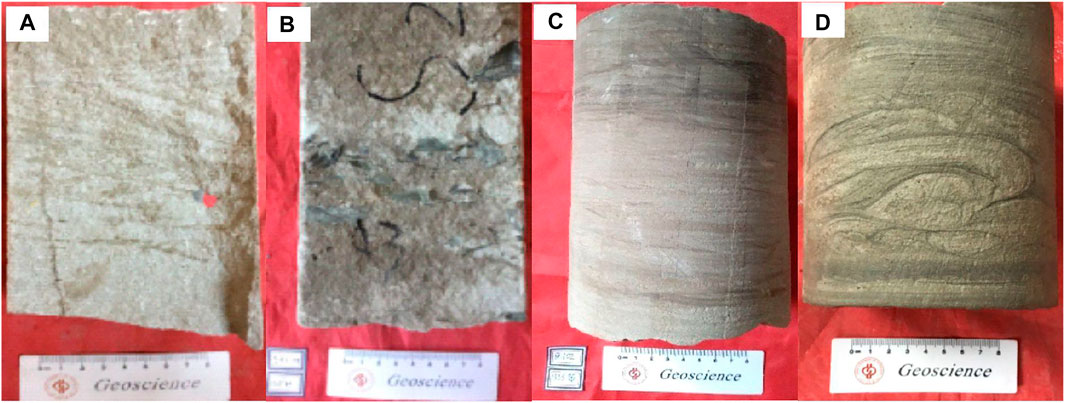
FIGURE 2. Core characteristics of the Quan 3 Member in the Fuxin Uplift. Notes: (A) Point bar, fine sandstone with wedge cross bedding, Well J+28–015.1,1272.62m; (B) Distributary channel, fine sandstone with argillaceous gravel, Well J+2–014, 1373.97m; (C) Distributary channel, silt-finesandstone with small-scale cross bedding, Well M102, 1353.95m; (D) Delta front underwater distributary channel, fine sandstone with convolution bedding, Well J30, 439.73m.
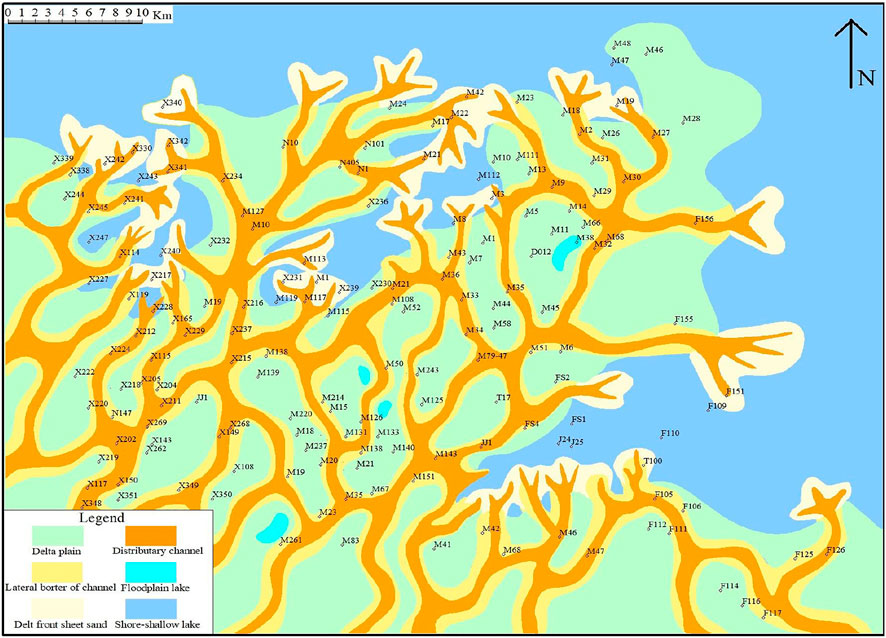
FIGURE 3. Distribution of sedimentary facies of the I sandstone group of the Quan 3 Member in the Fuxin Uplift.
The evaluation and classification of reservoirs are controlled by petrological property parameters (Yang and Chen., 2001; Zhang J. Y. et al., 2014; Radwan et al., 2021; Nabawy et al., 2022). In order to better study the reservoir properties of the Quan 3 Member in the Fuxin Uplift Belt, the rock characteristics of the reservoir were first analyzed, and then the rock types, components and structural characteristics were clarified.
In this study, the petrological characteristics of the target layer in the study area were qualitatively and quantitatively analyzed using the data of ordinary thin section identifications, X-diffractions and scanning electron microscope analysis.
Under the microscope, it is found that there are differences in the lithological development characteristics of different regions and different depths, and the oil content is quite different. The feldspar lithic sandstone is mainly developed in the target layer, and the calcareous sandstone is developed in the local layers. Among them, feldspar and debris components are mostly chloritized. The debris composition is dominated by medium-acid extrusive debris (Figures 4A,B), and contains a certain amount of basic extrusive debris (Figures 4C,D). Perpendicular to the bedding direction, the particle size is relatively finer from bottom to top, but the degree of fine-graining is not large, and the average particle size of each small layer is between 0.1 and 0.15 mm. In addition, some sandstone segments have high calcareous content (Figures 4E,F) and argillaceous matrix (Figures 4G,H).
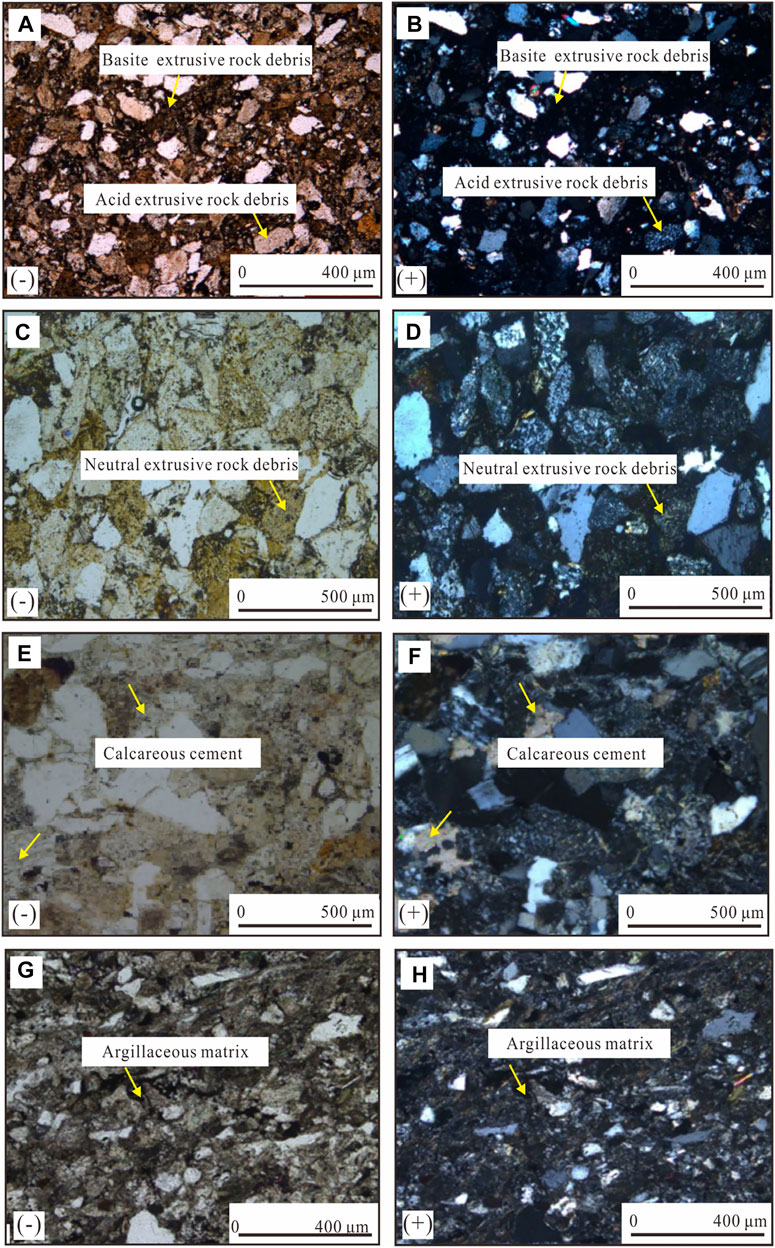
FIGURE 4. Microscopic characteristics of sandstones in Quan 3 Member in the Fuxin Uplift. Notes: (A) Feldspar debris sandstone, Jian 25 well, 389.32m; (B) Feldspar debris sandstone, Jian 25 well, 389.32m; (C) Feldspar debris sandstone, Jian 24 well, 504.26m; (D) Feldspar debris sandstone, Jian 24 well, 504.26m; (E) Calcareous sandstone, Ji+28–15.1 well, 1364.68m; (F) Calcareous sandstone, Ji+28–15.1 well, 1364.68m; (G) Argillaceous siltstone, Mu+126–024 well, 954.07m; (H) Argillaceous siltstone, Mu+126–024 well, 954.07m.
In this study, a statistical analysis was carried out on the measured physical property data (Table 1; Figure 5) of the sandstone cores of the Quan 3 Member. The results show that the porosity of the target layer is distributed between 3% and 34.9%, with an average of 14.3%. It has two peak intervals, the main peak is 10%–15%, and the secondary peak is 15%–20%. In addition, its permeability has a minimum value of 0.01 mD, a maximum value of 3167 mD, and an average of 3.84 mD. The permeability also has two peak intervals, the main peak is located at 1 mD-10 mD, and the secondary peak is located at 0.1 mD-1 mD. Obviously, the Quan 3 Member reservoir has moderately low porosity and low permeability (Figure 5).
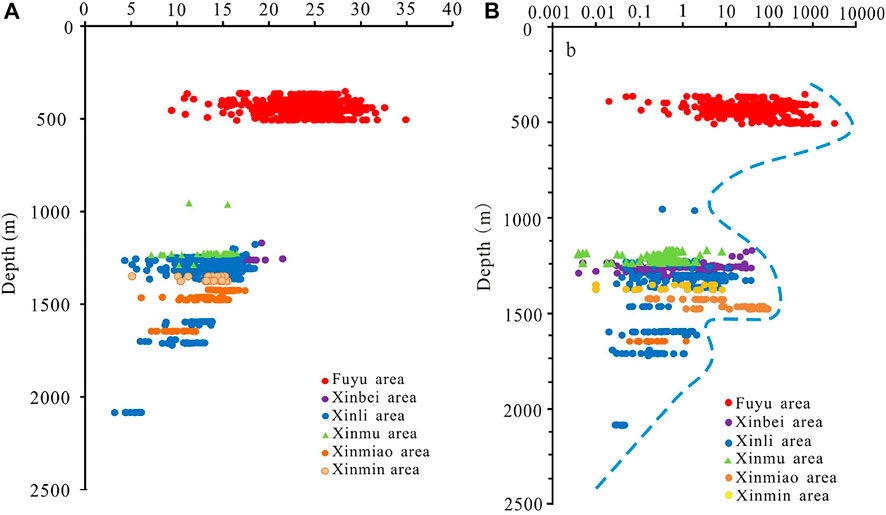
FIGURE 5. Distribution of reservoir properties of Quan 3 Members in different burial depth. Notes: (A) Varition of porosity with depth; (B) Varition of permeability with depth.
Controlled by various factors such as deposition and diagenesis, the distribution of physical properties on the plane is non-uniform, reflecting the obvious heterogeneity of reservoir physical properties (Zhang et al., 2014b; Xiao et al., 2019; Zhang et al., 2020; Zhang et al., 2022). The reservoir porosity of the Quan 3 Member is significantly different between the eastern and western regions (Table 1; Figure 5). The sand bodies in the east are buried shallow, so the porosity is higher than that in the west. The distribution of reservoir permeability is consistent with the distribution of porosity, and the permeability in the east is higher than that in the west.
Among the three sandstone groups in the Quan 3 Member, the sandstone group I has the best physical properties (Figure 6). The main peak of porosity is between 15% and 20%, and the main peak of permeability is between 1 mD-10 mD. The areas with porosity greater than 25% and permeability greater than 100 mD in the I sandstone group are mainly concentrated in the southeastern region. However, the areas with porosity greater than 20% and permeability greater than 1 mD are concentrated in the eastern part of the I sandstone group. The southwestern part of the study area is the Xinli Structure, and the permeability and porosity are basically above 1 mD and 15%. On the whole, the physical properties of the reservoir have a distribution pattern of “better in the southeast, poor in the southwest, and moderate to poor in the north".
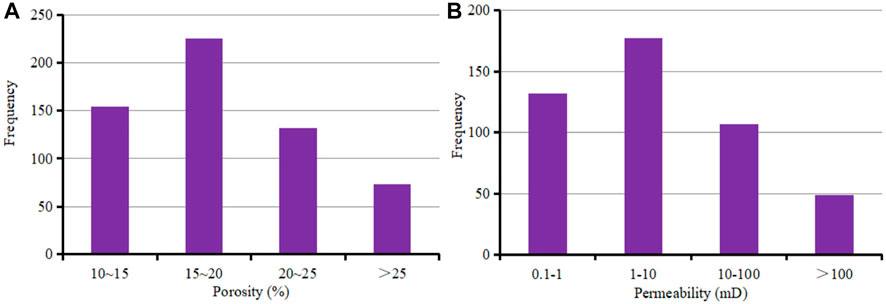
FIGURE 6. Distribution of porosity and permeability of I sandstone group in Quan 3 Member. (A) Porosity distribution histogram; (B) Permeability distribution histogram.
The type of pores plays an important role in the accumulation of oil and gas (Wang and Yang., 2017; Santosh and Feng., 2020; Zhang et al., 2021; Su et al., 2022). The pore types of the target layer are mainly dissolved intergranular and intragranular pores, followed by primary intergranular pores, and micro-fractures are occasionally seen.
1) Secondary pores
The secondary pores developed in the target layer are mainly dissolved pores. For example, dissolved intragranular pores, dissolved intergranular pores (dissolved and expanded intergranular pores, cement dissolved pores) and mold pores.
①Intragranular dissolution pores
The most common is the dissolution of feldspar particles. Due to the cleavage of feldspar, when the acidic fluid enters, the feldspar is dissolved in a grid-like manner, and a dissolved residual edge is formed (Figures 7A,B). Neutral and basic debris in the study area contain feldspar, and the feldspar component can also be dissolved, resulting in dissolved intragranular pores in the debris (Figures 7C,D).
②Intergranular dissolution pores
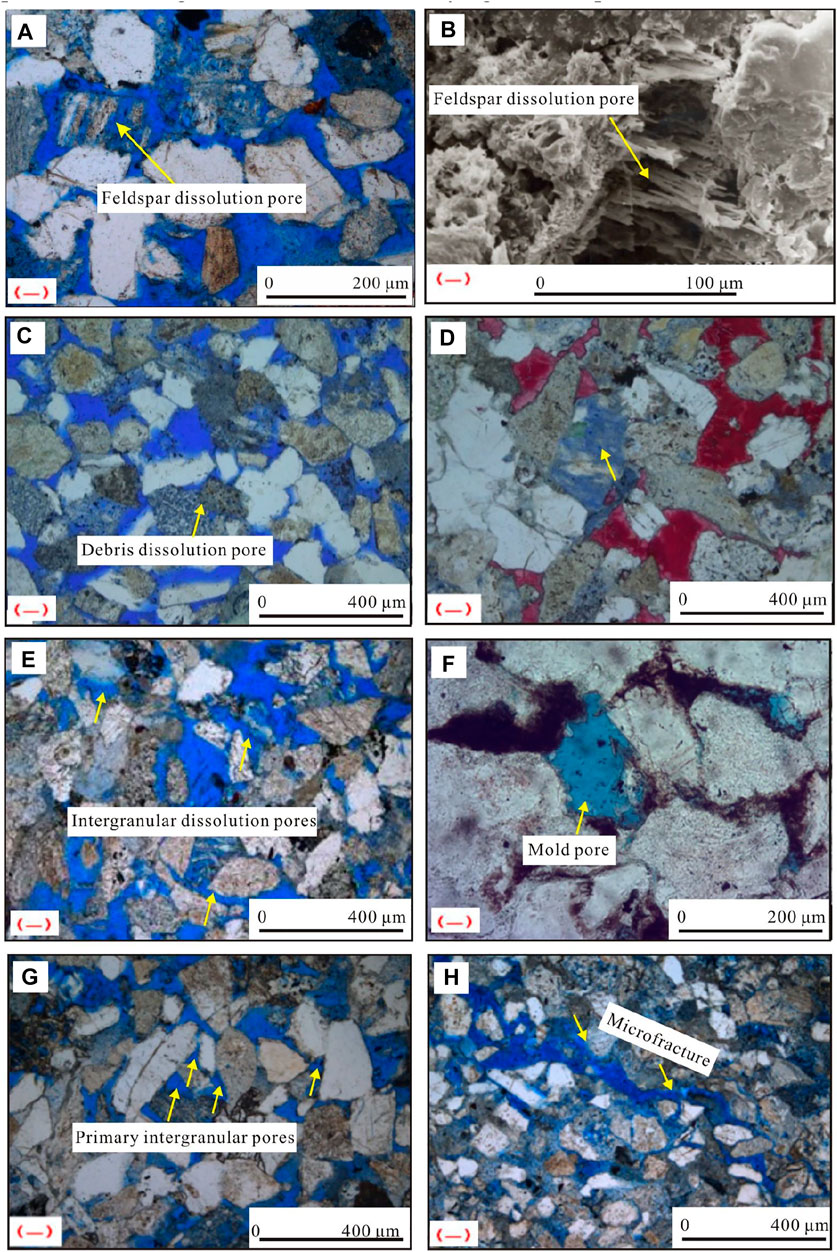
FIGURE 7. Development characteristics of pores in the sandstone of the target layer. Notes: (A) Feldspar dissolution pores, Jian 25 well, 460.24m; (B) Feldspar dissolution pore, Ji 41 well, 1369.76m; (C) Detritus dissolution pores, Jian 24 well,495.4m; (D) Debris dissolution pores, Ji+28–15.1 well, 1324.42m; (E) Fine feldspar debris-siltstone, well developed pores, Jian 30 well, 370.0m; (F) Mould pores, Ji +28–015.1 well, 1364.75m; (G) Primary pores, Jian 30 well, 458.1m; (H) Fine feldspar debris-siltstone, micro-fractures, Jian 25 well, 418.34m.
Dissolution and enlarged intergranular pores can also be seen in the target layer (Figure 7E). The acidic fluid dissolves the unstable components around the primary pores, so that the primary pores are enlarged. The pore space around the particles is mostly irregular or harbor-shaped.
③Mold pores
For selective dissolution, the relatively soluble particles are completely dissolved, leaving a dissolved pore with the same size and shape as the dissolved particles, that is, a mold pore. The mold pores produced by the complete dissolution of feldspar particles by organic acids can be seen in the target layer (Figure 7F).
2) Primary pores
Primary pores refer to the pores formed during the deposition of rocks and preserved to the present. After they are formed, they have not suffered from major diagenesis, such as dissolution or cementation, to reform the intergranular pores, so they have the characteristics of regular shape and straight edges (Tang et al., 2009; Sun et al., 2013). The preserved primary pores are generally developed between the clast particles, and are mostly triangular, and the pore boundaries retain relatively straight boundaries. Moreover, some primary pores are developed between the clay mineral crystals, such as the intercrystalline pores of kaolinite and illite. They are distributed in irregular shapes. The content of primary pores in the target layer is low, and the connectivity between pores is poor (Figure 7G).
3) Micro-fractures
Structural fractures and pressure-solution fractures are mainly developed in the target layer (Figure 7H). Structural fractures generally pass around the grains, and the fracture surfaces are curved. The pressure-dissolution fractures are generally distributed in the same direction on the feldspar particles, showing the direction of the overlying load compressive stress.
According to the mercury intrusion test results, the pore-throat structures of the reservoir in the Quan three Member are divided into four types: 1) small-pore medium-throat type, 2) small-pore micro-throat type, 3) small-pore micro-throat type, 4) micro-pore micro-throat type.
Type I: small-pore medium-throat type. The pore throats in this type of pore-throat system are relatively large, with ϕ (porosity) between 24% and 27%, permeability between 368 and 603 mD, average pore throat radius distribution around 10 μm, displacement pressure between 0.02 MPa and 0.2 MPa, and median pressure of saturation between 0.4 MPa and 0.9 MPa. Moreover, the mercury injection curve has a certain length of gentle slope platform, and the mercury removal efficiency is between 12% and 14%, with an average of 13%. This type of reservoir has fine pore throat and good sorting, and is mainly developed in the Fuyu Oilfield. It is the best reservoir in the Quan 3 member of the Quanzhou Formation, and is generally distributed in point bars and delta distributary channels (Figure 8A).
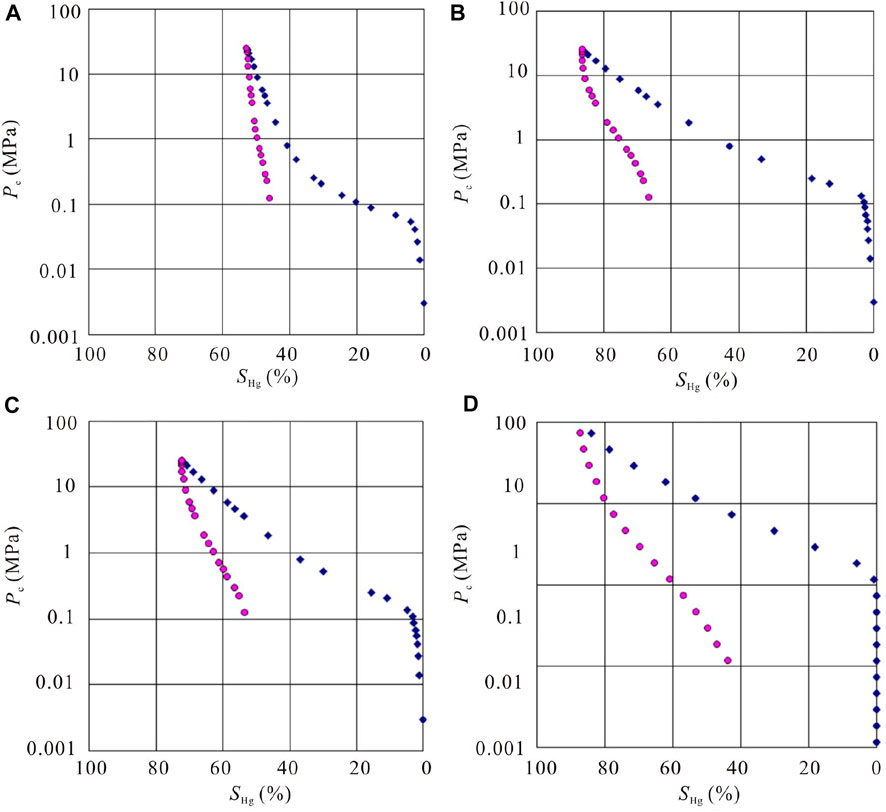
FIGURE 8. Classification results of pore throat types of tight sandstones in the Quan 3 Member. Notes: (A) Type I reservoir, Jian 24 well, 364.93m; (B) Type II reservoir, Jian 24 well, 418.55m; (C) Type III reservoir, Xin 269 well, 1264.45m; (D) Type IV reservoir, Xin 207 well, 1180.00m.
Type II: small-pore micro-throat type. The pore throat radius in this type of pore throat system is lower than that of the Type I pore throats. Its ϕ is between 15% and 22%, with an average value of 17.3%. There is almost no near-horizontal segment in the mercury intrusion curve. The average displacement pressure is 0.2 MPa, and the average pore throat radius is between 0.1 and 1 mm. Moreover, the maximum mercury saturation is 82%–87%, with an average of 84%, and the mercury removal efficiency is 28%–50%, with an average of 37.8%. The permeability distribution range of this type of reservoir is 0.5mD-1.7mD, and the porosity is mostly less than 18%. This type of reservoir has fine pore throats, poor sorting, and small seepage space, and is generally distributed in point bar sand bodies (Figure 8B).
Type III: small-pore micro-throat type. The pores and roars in the pore-throat system of this type of reservoir are smaller than those of Type II. Its ϕ is between 14% and 18%, with an average value of 15.7%. The mercury intrusion curve is similar to Type II. The average pore radius is distributed in the range of 1–3 μm, with an average value of 2.0 μm. The displacement pressure is distributed in the range of 0.15–2.08 MPa. This type of reservoir is generally distributed in natural levee (Figure 8C).
Type IV: micro-pore micro-throat type. Its ϕ is between 11% and 14%, with an average value of 13.1%; the average pore radius is between 0.17 and 0.97 μm, with an average value of 0.64 μm. In addition, the displacement pressure is > 4 MPa. This type of reservoir is mainly developed in floodplains and inter-tributary bays (Figure 8D).
The reservoirs below 1500 m in the study area have poor physical properties and tend to be densified evidently (Figure 5). When the reservoir is tight, industrial-grade oil flow cannot be produced. Combining the observations of the core and the data of liquid production and physical properties, it can be seen that the physical property boundary between oil-free and oil-bearing in the core is between the porosity of 10% and the permeability of 0.1 mD (Figure 9). The limit of daily liquid production less than 1t is between ϕ = 10% and K = 1 mD (Figure 10). Therefore, the lower limits of the effective reservoir physical properties of the Quan 3 Member reservoir is: porosity of 10% and permeability of 0.1 mD.
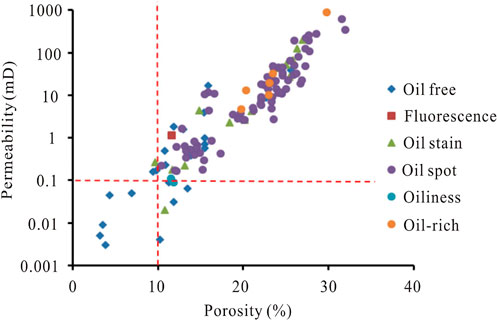
FIGURE 9. Relationship between oil content and physical properties revealed by the cores of the Quan 3 Member.
According to the mercury intrusion curve characteristics, physical properties, pore-throat combinations, and sedimentary facies, the target layers are divided into four categories (Table 2): Medium-small pore, medium-throat, medium-high permeability reservoir (Type I); small-pore, fine-throat, low-permeability reservoir (Type II), small pore,d fine throat, extra-low permeability reservoir (Type III), and micro-pore, micro-throat, ultra-low permeability reservoir (Type IV).

TABLE 2. Statistical results of physical properties of different types of reservoirs in the Quan 3 Member of the Quantou Formation in the study area.
Type I reservoir: It is dominated by medium-small pore and medium-throat, and the permeability is between 200 mD and 900 mD, with an average value of 433 mD; ϕ (porosity) > 25%, the average value of ϕ is 26.7%, and the average pore radius is > 4.5 μm; the maximum mercury saturation is between 61% and 93%, and the displacement pressure is between 0.04 MPa and 0.1 MPa. This type of reservoir is mainly located in the Fuyu Oilfield, and it is mainly developed in (underwater) distributary channels and point bars.
Type II reservoir: It is dominated by small pores and fine throats, and the permeability is between 13 mD and 80 mD, with an average value of 52.4 mD; ϕ = 20%–25%, the average value is 22.3%; the average pore radius is between 1 and 4μm, and the average value is 2.5 μm; moreover, the displacement pressure is between 0.09 MPa and 0.15 MPa, and the average value is 0.11 MPa. This type of reservoir is mainly developed in point bar.
Type III reservoir: It is mainly composed of small pores and fine throats, and the permeability is between 1 mD and 40 mD, with an average value of 18 mD; ϕ = 15%–20%, the average value is 15.7%; the average pore radius is between 1 and 3 μm, and the average value is 2.0 μm; the displacement pressure is between 0.15 and 2.08 MPa. Reservoirs of this type are mainly located in the Xinmu and Xinmiao Oilfields, and are mainly developed in natural levees and inter-tributary bays.
Type IV reservoir: It is mainly composed of micro-pores and micro-throats, with a permeability of 0.5 mD to 5 mD and an average value of 2.12%; ϕ = 11%–14%, and its average is 13.1%; the average pore radius ranges from 0.17 to 0.97 μm, and the average value is 0.64 μm; the displacement pressure is greater than 4 MPa. Reservoirs of this type are mainly located in the Xinli Oilfield, and are mainly developed in floodplains and inter-tributary bays.
In this paper, the planar distribution of different types of reservoirs in the I sandstone group of the Quan three Member is predicted according to the established reservoir classification standard. In the sandstone group I, the overall quality of the reservoir is good, the effective reservoir can reach the entire Fuxin Uplift Belt, and the sand bodies are well connected with each other.
Type I reservoir sweet spots are mainly developed in the Fuyu Oilfield in the southeast (Figure 11). The sandstones in this area suffered less compaction, and mainly developed primary pores and secondary pores formed by late dissolution.
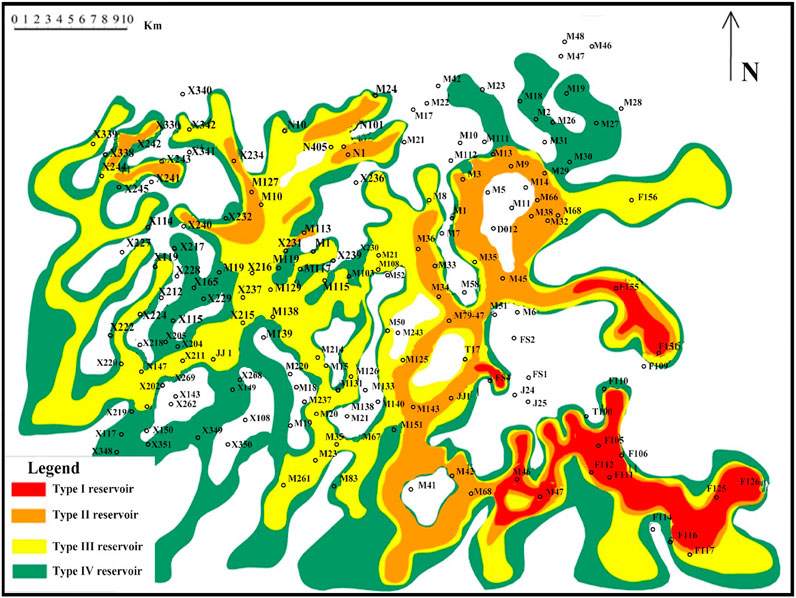
FIGURE 11. Prediction of the reservoir distribution of the I sandstone group in the Quan 3 Member of the Quantou Formation in the study area.
Type II reservoirs are mainly developed in point bar bodies of the Xinmin Oilfield in the northeast (Figure 11). There are also a small number of Type II reservoirs in the point bars in the southeast of the Xinmu Oilfield, which are mainly due to shallow burial, less compaction and lower cement content. In addition, a certain amount of Type II reservoirs are developed in the northern part of the Xinli and Xinmiao Oilfields, which are mainly controlled by organic acid dissolution. The organic acid dissolution effectively improves the physical properties of the reservoir (Zhang et al., 2014c; Yin and Wu., 2020).
Type III reservoirs are mainly developed in the branch channel sand bodies of the Xinmu, Xinbei and Xinmin Oilfields in the central part (Figure 11). Due to its small particle size and lack of organic acid dissolution, its physical properties are relatively poor. A certain amount of Type III reservoirs are also developed in the west of the Xinli Oilfield, which are mainly located in the Xinli Structural Belt, and their burial depth is relatively shallow.
Type IV reservoirs are mainly developed in the point bars of the Xinli Oilfield (Figure 11). Its burial depth is relatively large, and the compaction effect is strong. The diagenetic stage is mostly in the middle diagenetic A2 stage, which has been cemented by iron calcite, and it is difficult to effectively improve its physical properties by dissolution.
1) In this paper, taking the Quan 3 Member in the Fuxin Uplift Belt of the Songliao Basin as an example, the microscopic pore structure characteristics of tight oil sandstones have been systematically studied, and the classification standard of tight sandstones has been formulated. Furthermore, the sweet spots of the main production layers are predicted.
2) The sedimentary facies of the Quan 3 Member in the study area are meandering river facies and shallow water delta facies. Feldspar lithic fine sandstones are developed in the target layer, and calcareous sandstone is locally developed. Moreover, the mian pore types of the target layer include dissolved intergranular and intragranular pores, followed by primary intergranular pores, and micro-fractures are occasionally seen.
3) According to the mercury intrusion test results, the pore-throat structures of the reservoir in the Quan 3 Member are divided into four types: (1) small-pore medium-throat type (point bar and delta distributary channel), (2) small-pore micro-throat type (point bar), (3) small-pore micro-throat type (natural levee), (4) micro-pore micro-throat type (river floodplain and inter-tributary bay).
4) The lower limits of the physical properties of the effective reservoirs in the Quan 3 Member has been determined: the porosity is 10% and the permeability is 0.1 mD. Finally, combined with mercury intrusion curves, physical property tests and sedimentary facies characteristics, the classification standard of the Quan 3 Member reservoirs was formulated.
5) For the I sandstone group, the sweet spots of the Type I reservoirs are mainly developed in the Fuyu Oilfield in the southeast areas. The sandstones in this area suffered less compaction, and primary and secondary pores that suffered from late dissolution are mainly developed.
The original contributions presented in the study are included in the article/Supplementary Material, further inquiries can be directed to the corresponding author.
QZ is responsible for the idea and writing of this paper, and YZ, BW, SY, XW, and CY are responsible for the data and analysis.
This manuscript was supported by the National Natural Science Foundation of China (Grant No. 41872134 and No. 41302081) and Jilin Oilfield Branch Company Ltd., PetroChina (Grant No. HX20180033).
YZ was employed by the Petroleum Exploration and Production Research Institute, SINOPEC. BW was employed by the Sinopec Chongqing Fuling Shale Gas Exploration and Development Co., Ltd.
The remaining authors declare that the research was conducted in the absence of any commercial or financial relationships that could be construed as a potential conflict of interest.
All claims expressed in this article are solely those of the authors and do not necessarily represent those of their affiliated organizations, or those of the publisher, the editors, and the reviewers. Any product that may be evaluated in this article, or claim that may be made by its manufacturer, is not guaranteed or endorsed by the publisher.
Bello, A. M., Jones, S., Gluyas, J., Acikalin, S., and Cartigny, M. (2021). Role played by clay content in controlling reservoir quality of submarine fan system, Forties Sandstone member, Central Graben, North Sea. Mar. Petroleum Geol., 128, 105058. doi:10.1016/j.marpetgeo.2021.105058
Boutaleb, K., Baouche, R., Sadaoui, M., and Radwan, A. E. (2022). Sedimentological, petrophysical, and geochemical controls on deep marine unconventional tight limestone and dolostone reservoir: Insights from the Cenomanian/Turonian oceanic anoxic event 2 organic-rich sediments, Southeast Constantine Basin, Algeria. Sediment. Geol. 429, 106072. doi:10.1016/j.sedgeo.2021.106072
Cui, X., and Radwan, A. E. (2022). Coupling relationship between current in-situ stress and natural fractures of continental tight sandstone oil reservoirs. Interpretation 10 (3), SF9–SF21. doi:10.1190/int-2021-0200.1
Enayati-Bidgoli, A., and Saemi, E. (2019). Effects of late diagenesis on primary reservoir quality of a quartz arenite unit: A case study from the lower cretaceous successions of SW Iran. Pet. Sci. 16 (2), 267–284. doi:10.1007/s12182-019-0306-x
Haile, B. G., Klausen, T. G., Czarniecka, U., Xi, K., Jahren, J., and Hellevang, H. (2018). How are diagenesis and reservoir quality linked to depositional facies? A deltaic succession, edgeøya, svalbard. Mar. Petroleum Geol. 92, 519–546. doi:10.1016/j.marpet-geo.2017.11.019
Hijaz, K. H., Adrian, S., Meor, H. A. H., and Abdullah, W. H. (2020). Digital core analysis: Characterizing reservoir quality through thin sandstone layers in heterolithic rocks, J. Appl. Geophys., 182, 178–210. doi:10.1016/j.jappgeo.2020.104178
Jabir, A., Cerepi, A., Loisy, C., and Rubino, J. L. (2021). Evaluation of reservoir systems in Paleozoic sedimentary formations of Ghadames and Jefarah basins, J. Afr. Earth Sci., 183, 104324–104327. doi:10.1016/j.jafrearsci.2021.104324
Kassem, A. A., Hussein, W. S., Radwan, A. E., Anani, N., Abioui, M., Jain, S., et al. (2021). Petrographic and diagenetic study of siliciclastic Jurassic sediments from the Northeastern Margin of Africa: Implication for reservoir quality. J. Petroleum Sci. Eng. 200, 108340. doi:10.1016/j.petrol.2020.108340
Khan, E. U., Saleem, M., Naseem, A. A., Ahmad, W., Yaseen, M., and Khan, T. U. (2020). Microfacies analysis, diagenetic overprints, geochemistry, and reservoir quality of the jurassic samanasuk. Formation at the kahi section, nizampur basin, NW himalayas, Pakistan. Carbonates Evaporites 35 (3), 95–96. doi:10.1007/s13146-020-00622-4
Li, F. J., Wang, D. Y., and Xu, X. H. (2005). The influential factors and charactristics of triassic yanchang formantion reservior in longdong area, ordos basin. Pet. Exp. Geol. 27 (4), 355–370. doi:10.1016/j.molcatb.2005.02.001
Li, J. J., Wang, Z. Z., and Zhang, Z. H., (2013). The sedimentary facies of member-3 of Quantou Formation in Xinli oilfield, Songliao Basin. Xinjiang Pet. Geol., 5(8), 534–537.
Liu, D. K., Sun, W., and Ren, D. Z., (2019). Experimental investigation of pore structure and movable fluid traits in tight sandstone, Process. (Basel)., Experimental investigation of pore structure and movable fluid traits in tight sandstone. Processes, 7(3), 149–156. doi:10.3390/pr7030149
Lv, T. X., and Li, Z. P. (2021). Quantitative characterization method for microscopic heterogeneity in tight sandstone. Energy Explor. Exploitation 13, 1076–1096. doi:10.1177/0144598721993937
Mahmi, O., Dypvik, H., and Hammer, E. (2018). Diagenetic influence on reservoir quality evolution, examples from Triassic conglomerates/arenites in the Edvard Grieg field, Norwegian North Sea. Mar. Petroleum Geol. 93, 247–271. doi:10.1016/j.marpetgeo.2018.03.006
Mirzaei-Paiaman, A., and Ghanbarian, B. (2021). A new methodology for grouping and averaging capillary pressure curves for reservoir models. Energy Geosci. 2 (1), 52–62. doi:10.1016/j.engeos.2020.09.001
Nabawy, B. S., Abudeif, A. M., Masoud, M. M., and Radwan, A. E. (2022). An integrated workflow for petrophysical characterization, microfacies analysis, and diagenetic attributes of the Lower Jurassic type section in northeastern Africa margin: Implications for subsurface gas prospection. Mar. Petroleum Geol. 140, 105678. doi:10.1016/j.marpetgeo.2022.105678
Qiao, J. C., Zeng, J. H., Jiang, S., Feng, S., Feng, X., Guo, Z., et al. (2019). Heterogeneity of reservoir quality and gas accumulation in tight sandstone reservoirs revealed by pore structure characterization and physical simulation, Fuel, 253, 1300–1316. doi:10.1016/j.fuel.2019.05.112
Radwan, A. E., Rohais, S., and Chiarella, D. (2021). Combined stratigraphic-structural play characterization in hydrocarbon exploration: A case study of middle miocene sandstones, gulf of suez basin, Egypt. J. Asian Earth Sci., 218, 104686. doi:10.1016/j.jseaes.2021.104686
Santosh, M., and Feng, Z. Q. (2020). New horizons in energy geoscience. Energy Geosci. 1 (1–2), 1–2. doi:10.1016/j.engeos.2020.05.005
Su, Y., Zha, M., Jiang, L., Ding, X., Qu, J., Jin, J., et al. (2022). Pore structure and fluid distribution of tight sandstone by the combined use of SEM, MICP and X-ray micro-CT, J. Petroleum Sci. Eng., 208, 109241–109245. doi:10.1016/j.petrol.2021.109241
Sun, Y., Chen, C., and Ma, S. Z., (2013). Hydrocarbon migration mechanism and mccumulation models of the Fuyu oil layer in southern Fuxin uplift, Songliao Basin. Geol. Rev., 59 (3), 501–509. doi:10.16509/j.georeview.2013.03.006
Sun, Y., Zhang, J. Y., and Ma, S. Z., (2014). Analysis of high-resolution sequence stratigraphy of Fuyu oil layer in the southern Fuxin Uplift. Geol. Rev., 3, 473–480.
Tang, Z. X., Bai, L. D., and Gui, P. (2009). Exploration practice of old oil area in Fuxin uplift, southern Songliao Basin. Pet. Geol. 4, 17–20. doi:10.3969/j.issn.1672-7703.2009.04.004
Wang, W. G., Lin, C. Y., Zhang, X. G., Dong, C., Ren, L., and Lin, J. (2020). Effect of burial history on diagenetic and reservoir-forming process of the Oligocene sandstone in Xihu sag, East China Sea Basin, Mar. Petroleum Geol., 112, 104034–104035. doi:10.1016/j.marpetgeo.2019.104034
Wang, W., Li, R. L., and Zhao, H. W., (2016) Combined pattern of controlled depression fault and its influence on hydrocarbon accumulation in southern part of Songliao Basin Fault Group. Unconv. oil gas, 3(5), 14–20.
Wang, Z., and Yang, G. Q., (2017). Some research hot spots of tight oil and gas reservoir. Chin. foreign energy, 16(8), 37–42.
Wu, Y., Tahmasebi, P., Lin, C., Zahid, M. A., Dong, C., Golab, A. N., et al. (2019). A comprehensive study on geometric, topological and fractal characterizations of pore systems in low-permeability reservoirs based on SEM, MICP, NMR, and X-ray CT experiments. Mar. Petroleum Geol. 103, 12–28. doi:10.1016/j.marpetgeo.2019.02.003
Wu, Y., Tahmasebi, P., Lin, C., and Dong, C. (2020c). A comprehensive investigation of the effects of organic-matter pores on shale properties: A multicomponent and multiscale modeling. J. Nat. Gas. Sci. Eng. 81, 103425. doi:10.1016/j.jngse.2020.103425
Wu, Y., Tahmasebi, P., Lin, C., and Dong, C. (2020b). Process-based and dynamic 2D modeling of shale samples: Considering the geology and pore-system evolution. Int. J. Coal Geol. 218, 103368. doi:10.1016/J.COAL.2019.103368
Wu, Y., Tahmasebi, P., Yu, H., Lin, C., Wu, H., and Dong, C. (2020a). Pore-scale 3D dynamic modeling and characterization of shale samples: Considering the effects of thermal maturation. J. Geophys. Res. Solid Earth 125 (1), 1–10. doi:10.1029/2019JB018309
Xiao, Z. K., Ding, W. L., Hao, S. Y., Taleghani, A. D., Wang, X., Zhou, X., et al. (2019). Quantitative analysis of tight sandstone reservoir heterogeneity based on rescaled range analysis and empirical mode decomposition: A case study of the chang 7 reservoir in the dingbian oilfield, J. Petroleum Sci. Eng., 182, 106326–106347. doi:10.1016/j.petrol.2019.106326
Yang, S. S., Zhang, J. C., and Huang, W. D., (2013). “Sweet spot” types of reservoirs and gGenesisof tights and stone gas in Kekeya area, Turpan-Hami Basin. J. petroleum, 34(2), 272–282.
Yang, X. P., and Chen, L. H. (2001). Study on diagenetic facies of low permeability reservoir of Yanchang Formation in Shanbei Slope. Petroleum Explor. Dev. 28 (4), 38–40. doi:10.3321/j.issn:1000-0747.2001.04.011
Yin, S., and Wu, Z. (2020). Geomechanical simulation of low-order fracture of tight sandstone. Mar. Petroleum Geol. 100, 359–369. doi:10.1016/j.marpetgeo.2020.104359
Zhang, B., Shen, B., and Zhang, J. (2020). Experimental study of edge-opened cracks propagation in rock-like materials. J. Min. Strata Control Eng. 2 (3), 033035. doi:10.13532/j.jmsce.cn10-1638/td.20200313.001
Zhang, J. Y., Sun, Y., and Tian, X. L., (2014a). Provenance analysis on the Fuyu reservoir in xinmiaoxi-xinbei regions of the northern Fuxin uplift, Songliao Basin. Sci. Technol. Eng., 14 (26): 200 ∼ 204.
Zhang, Q., Wu, X., Radwan, A., Wang, B., Wang, K., Tian, H., et al. (2022). Diagenesis of continental tight sandstone and its control on reservoir quality: A case study of the quan 3 member of the cretaceous Quantou Formation, Fuxin uplift, Songliao Basin. Mar. Petroleum Geol. 145, 1–10. doi:10.1016/j.marpetgeo.2022.105883
Zhang, Q., Zhu, X. M., and Mao, L. (2021). Pore evolution and Genesis of secondary pores in the paleogene dainan formation, jinhu sag, subei basin. Earth Sci. Front. 28 (1), 190–201. doi:10.13745/j.esf.sf.2020.5.18
Zhang, Q., Zhu, X. M., and Steel, R. J., (2014b). Variation and mechanisms of clastic reservoir quality in the paleogene shahejie formation of the dongying sag, bohai bay basin, China. China Petroleum Science, 11(2), 200–210. doi:10.1007/s12182-014-0333-6
Keywords: Songliao Basin, tight oil sandstone, Quan 3 Member, reservoir classification, sweet spot prediction
Citation: Zhang Q, Zhang Y-X, Wang B-H, Yin S, Wu X-S and Yuan C-S (2022) Comprehensive evaluation and reservoir classification in the Quan 3 Member of the Cretaceous Quantou Formation in the Fuxin Uplift, Songliao Basin. Front. Earth Sci. 10:1016924. doi: 10.3389/feart.2022.1016924
Received: 11 August 2022; Accepted: 08 September 2022;
Published: 21 September 2022.
Edited by:
Yuqi Wu, China University of Petroleum, ChinaReviewed by:
Ziliang Liu, Chengdu University of Technology, ChinaCopyright © 2022 Zhang, Zhang, Wang, Yin, Wu and Yuan. This is an open-access article distributed under the terms of the Creative Commons Attribution License (CC BY). The use, distribution or reproduction in other forums is permitted, provided the original author(s) and the copyright owner(s) are credited and that the original publication in this journal is cited, in accordance with accepted academic practice. No use, distribution or reproduction is permitted which does not comply with these terms.
*Correspondence: Qin Zhang, emhhbmdxaW5AY3VwLmVkdS5jbg==
Disclaimer: All claims expressed in this article are solely those of the authors and do not necessarily represent those of their affiliated organizations, or those of the publisher, the editors and the reviewers. Any product that may be evaluated in this article or claim that may be made by its manufacturer is not guaranteed or endorsed by the publisher.
Research integrity at Frontiers

Learn more about the work of our research integrity team to safeguard the quality of each article we publish.